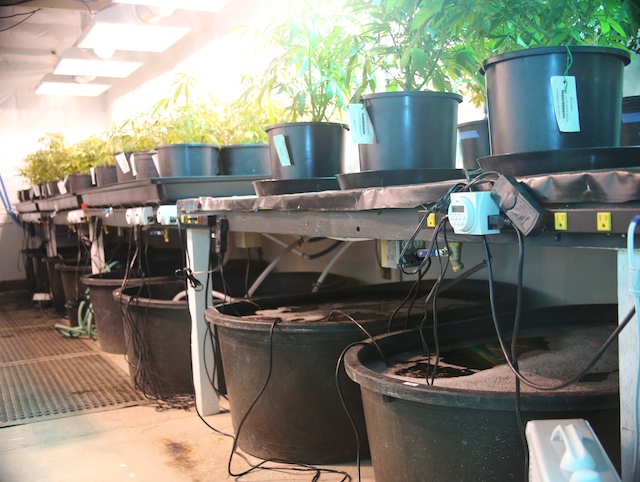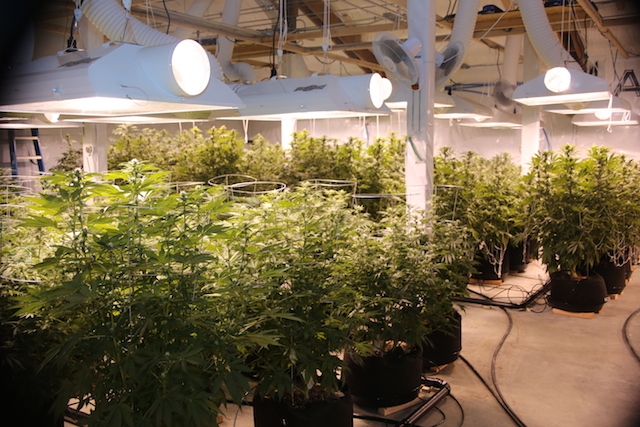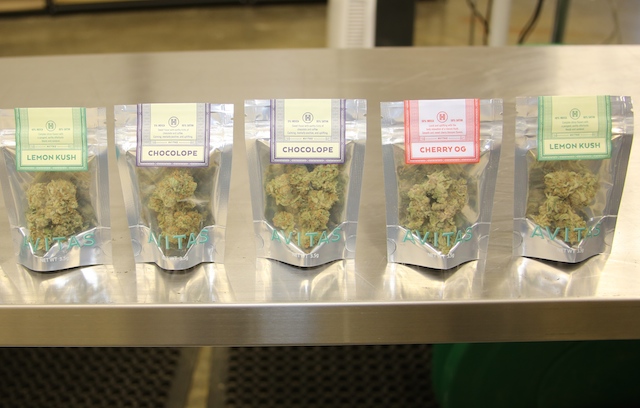Avitas Agriculture in Arlington, WA is a top cannabis producer and processor supplying great strains to a number of dispensaries statewide. Jason Smits and Adam Smith oversee this outstanding operation. We visited with Jason at his headquarters.
How long has Avitas been doing what it’s doing?
My partner Adam Smith and I have been working on this since November 2012, shortly before the historic vote to legalize marijuana for recreational purposes. As mentioned above we moved the plants into our facility around late June 2014.
How many on the Avitas staff?
Twelve people total. We also have two groups of lawyers and an accountant helping us out.
What’s you method of growing?
We grow indoors with HID lights for flowering and veg, and also use T5 fluorescents for mothers and clones. We have about 25 strains ready to be cloned at any time, and we have about 25 different seed varieties.
I try to use the best of both worlds — organics and technology – in all aspects of our operation. I call this a hybrid technique. For flowering, we use a coco-based, soilless potting mixture in 10 gallon Smartpots, but we water them automatically with a drip irrigation drain-to-waste system. I use the GH flora series of fertilizers supplemented with a few organic amendments.
We poured a radiant heated concrete floor to keep our root mass at the right temperature year-round. Our HID reflectors are air-cooled with 2050 cfm in-line fans. Each inline fan is hooked up to 8 lights and is custom-controlled by two fan speed controls on a cooling thermostat to regulate the canopy temperature. We only use CO2 in the winter, when natural CO2 levels outside get too low for optimum growth. My target is two pounds of dried flower per 1kW of light, and I have reached this goal and sustained it without CO2 in the past.
We do not use any odor control, as we are growing on a farm in an agricultural area. To control pests and diseases we use only pesticides allowed by the state. We can’t use any harsh chemicals like Avid or Floramite. To control mites we spray weekly rotating with neem, rosemary, azamax and a natural enzyme. We also employ three species of predatory mites bi-weekly.
For molds we spray weekly with a biological fungicide, and keep the humidity low with dehumidifiers. The organic fertilizer amendments keep our plants’ immune systems healthy as well.
I believe spider mite outbreaks are a symptom of laziness, uncleanliness and poor floor-plan design. You must be able to access the entire perimeter of your plants. We spray and employ the predatory mites whether we see any signs of mite damage or not.
The entire operation is continuous. We take new clones every two weeks, plant new flowering zones every two weeks like musical chairs and harvest weekly with different flowering times between the strains. We have dedicated veg zones and dedicated flowering zones, so we do not alter the light cycles in any given zone. The drying, trimming, weighing, and packaging process is ongoing as well.
Now that we are growing legally in Washington State, I can keep records of the entire operation. I am keeping records of everything including the types and quantities of fertilizers for each watering for each zone; records for the application of pesticides; calibration records for monitoring devices. We monitor and record the runoff to ensure we are not over-fertilizing. We keep continuous temperature and humidity records, harvest weights, etc. All of this information used to be evidence. Soon I will be able to optimize the entire operation by reviewing all of the records and comparing to harvest data.
Explain your reservoir system.
We have 16 reservoirs in the veg room, underneath the veg plant tables. This is simply because we are tight on space and want to maximize our flowering capacity. Fifteen of these tanks are dedicated for automatic watering to the flower zones. We hand-water all the veg and mother plants from the 16th reservoir.
Ten of these reservoirs are dedicated to a specific fertilizer recipe that supplies each flowering zone. Because we are planting every two weeks in flowering, there are different formulas for each stage of flowering depending on how far they are into flowering.
Each fertilizer (10 total) tank supplies a flower zone by a sump pump. Each sump pump has a check valve and 150-micron filter. The sump pumps are plumbed into the flowering room individually to one of ten manifolds on the floor. Two drip-irrigation lines for each plant are connected to the manifold and have 4 GPH drip-emitters on the ends. The sump pump filters sediment out of the drip-emitters so they never get clogged. The sump pumps are sized so the minimum pressure requirements on the emitters ensure we have a steady, consistent flow to each plant and we don’t have any dry pots.
The pots sit on lavarock in a tray that is plumbed to a drain line for each zone. We have a drain in the floor and pump our waste into a collection bin for offsite recycling and general farm usage on our property.
There are also 5 pure-water pH adjusted tanks. Each of these tanks has two sump pumps in them to “T” into two fertilizer tanks. (This is why we have check valves). This keeps the plumbing lines clean and helps to flush out and prevent fertilizer build up in the plants.
Each tank has a digital timer to water each zone at a specific time. I water 2-3 times daily. For the first three weeks of flowering, I water once with fertilizers at the start of the on-time, and once at the end of the cycle with a little bit of pure water. After three weeks the plants grow and get thirstier. So at this stage, they get an extra dose of fertilizer in the middle of the light-on time. If I miss one day of watering, the pots get too dry!
The fertilizer tanks also have a circulating pump with a filter to keep the mixture homogenous. Every tank also has an air stone connected to an air pump to keep them oxygenated.
We have a private well on our property with high iron and calcium. We use a sediment prefilter, then an iron filter, then a water softener, then finally an industrial RO filter. We supplement the RO water with a cal mag supplement before watering or mixing fertilizers.

Each fertilizer (10 total) tank supplies a flower zone by a sump pump.

Two drip-irrigation lines for each plant are connected to the manifold and have 4 GPH drip-emitters on the ends.
How many lights in flowering room?
We have 80 1kW HPS lights on digital ballasts. A total of ten flowering zones.
How many plants?
We typically have 256 in flowering, 140 in veg, 30 mother plants and various seeds and clones at any given time. Give or take. Every flowering zone has 4 ten-gallon potted plants per light.
How much do you expect to harvest?
We are harvesting 44-46 lbs. a month currently. But with a few tweaks, we will get 50-60 lbs a month very soon.

Avitas harvests go out to multiple Washington dispensaries.
Is this your first harvest as a licensed grower?
We’ve been harvesting weekly for about a month now. We started our first flowering cycle the start of July. With differences in flowering times we harvest every week now.
Who do you sell your products to?
Only licensed retailers, by law. Currently we supply a handful of retailers in Western Washington. Herbal Nation in Bothell, two places in Bellingham called Green Leaf and Top Shelf Cannabis,. Also, Cascade Kropz in Arlington. At the moment we are also getting orders ready for two stores that are opening next week: Green Theory in Bellevue, and Uncle Ike’s in Seattle.
Avitas handles both growing and processing. Can you explain what’s required in order to do that?
We have separate licenses — one for producing and one for processing. We are not taxed on internal transactions from production to processing areas. The entire processing operation is new to us, and we are learning as we go. We have to register our scales with the state.

Avitas is a licensed “processor.” They label and package their products.
The process is as follows: We strip the fan leaves during harvest and hang the plants to dry, then separate the buds off the branches into bins. Then they get a final hand trim. We then cure in jars, before packaging. Prior to packaging we send out QA samples to an independent lab for each five-pound lot of flower, or 15 lb. lot of trim. After we pass QA testing we can package and apply a results label.
The retail orders have to go into a 24-hour quarantine period before being shipped out. This gives the state time to audit our shipments if they want to.
Each order is tracked in a software system run by the state. The details of the shipments are tracked down to the exact rote from our facility to the retails and include a description of the delivery vehicle. Inside the vehicle, the packages must be locked in an area that is not accessible from the driver seat.
We weigh each dried flower bag manually and apply the strain and results labels manually right now. But we are ordering an automatic labeler to streamline the process. We are also starting to learn how to do pre-rolled joints with cones and a vibrating, cone-filling machine. We are ordering a press to turn our kief into hash and, hopefully, next year we will be able to start doing CO2 extracts of our flavors. We don’t have any plans for edibles currently.
Do you have plans to go to greenhouse?
Yes. We are currently reviewing bids for hybrid greenhouses and hope to have 30,000 square feet built in the first quarter of 2015. The greenhouses will have automatic dark-period controls and will be supplemented with artificial lighting so we can harvest year-round like an indoor operation.
The greenhouses will allow our entire operation to be hybrid in every sense. I actually consider these greenhouses to be an indoor grow supplemented with natural lighting.


















